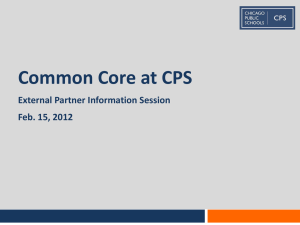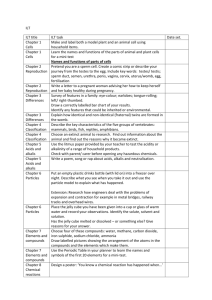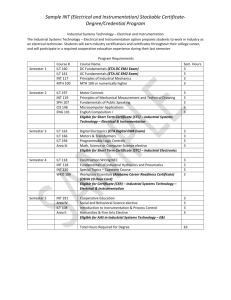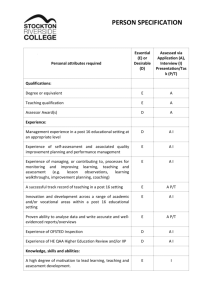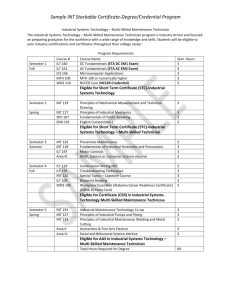Instructional Leadership Teams: Leading the Way to Successful
advertisement
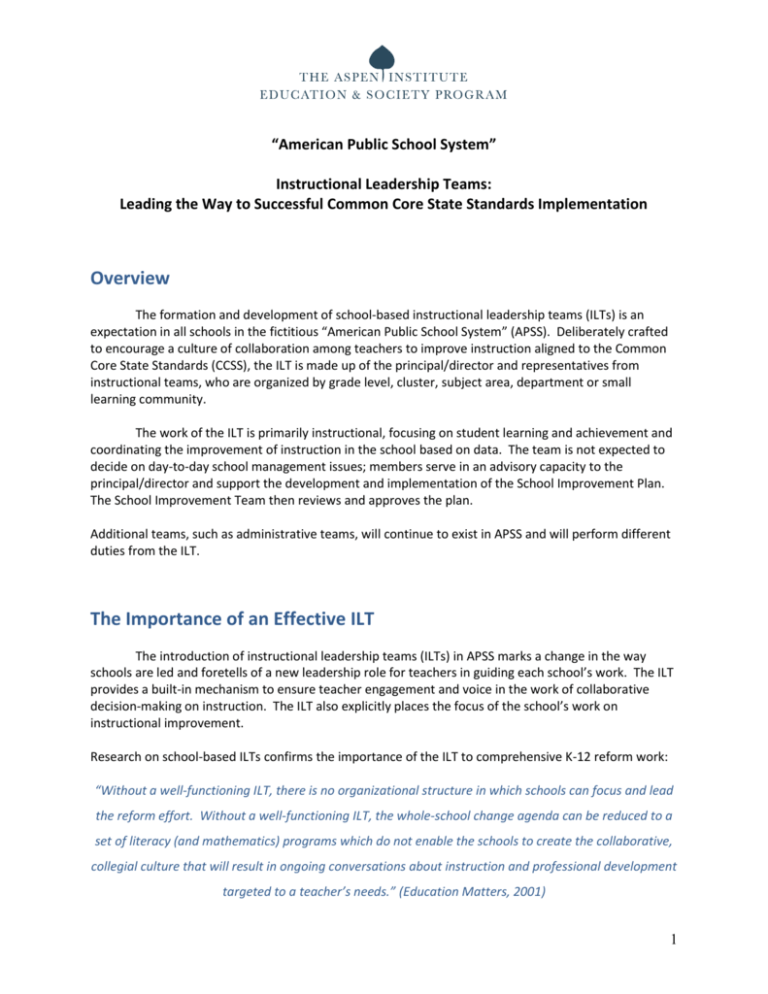
“American Public School System” Instructional Leadership Teams: Leading the Way to Successful Common Core State Standards Implementation Overview The formation and development of school-based instructional leadership teams (ILTs) is an expectation in all schools in the fictitious “American Public School System” (APSS). Deliberately crafted to encourage a culture of collaboration among teachers to improve instruction aligned to the Common Core State Standards (CCSS), the ILT is made up of the principal/director and representatives from instructional teams, who are organized by grade level, cluster, subject area, department or small learning community. The work of the ILT is primarily instructional, focusing on student learning and achievement and coordinating the improvement of instruction in the school based on data. The team is not expected to decide on day-to-day school management issues; members serve in an advisory capacity to the principal/director and support the development and implementation of the School Improvement Plan. The School Improvement Team then reviews and approves the plan. Additional teams, such as administrative teams, will continue to exist in APSS and will perform different duties from the ILT. The Importance of an Effective ILT The introduction of instructional leadership teams (ILTs) in APSS marks a change in the way schools are led and foretells of a new leadership role for teachers in guiding each school’s work. The ILT provides a built-in mechanism to ensure teacher engagement and voice in the work of collaborative decision-making on instruction. The ILT also explicitly places the focus of the school’s work on instructional improvement. Research on school-based ILTs confirms the importance of the ILT to comprehensive K-12 reform work: “Without a well-functioning ILT, there is no organizational structure in which schools can focus and lead the reform effort. Without a well-functioning ILT, the whole-school change agenda can be reduced to a set of literacy (and mathematics) programs which do not enable the schools to create the collaborative, collegial culture that will result in ongoing conversations about instruction and professional development targeted to a teacher’s needs.” (Education Matters, 2001) 1 These characteristics, which are summarized later in this overview, can be valuable to all ILT members, as the ILT reflects on its progress, assesses its effectiveness, and plans its work for the year. Responsibilities of the ILT Keep the focus of all work on improving student achievement in alignment with the CCSS. Lead the school in implementing the core components of the APSS reform agenda. Facilitate the self-assessment process and develop the school’s School Improvement Plan (SIP). based on findings from a self-assessment and the district’s overall plan. Throughout the year, track the school’s progress toward meeting the SIP goals and implementing the action steps. Align resources, professional development, and coaching to support teacher’s implementation of the SIP. Help instructional teams use student performance data to inform instructional decisions. Ensure that the school community reaches consensus on changes in instruction and assessment and that the voices of all stakeholders are included in the decision-making process. Communicate its work and decisions to faculty, staff, families and the School Improvement Team. Foster a culture of continuous and collaborative reflection, learning, and improvement. ILT Membership ILT Members Members of the ILT come from instructional teams Principal/Director (IT), organized by grade level, subject area, cluster Representatives include teachers from each instructional team and special instructional programs within the school. team, or small learning community. Members also include representatives of the school’s programs such as bilingual or special education. The Instructional Coaches principal/director, other representatives from the Other school administrators administration and instructional coaches also participate as members. While inclusiveness of staff members representing all groups in the Each instructional team sends a member to the ILT ILT Meeting Roles (suggested) student population is important, the group should Facilitator be fewer than 20, with 8-15 members being the Recorder preferred size to ensure that the team can be Timekeeper effective and efficient. Participants Members should rotate roles for each meeting 2 Members of effective ILTs share certain characteristics. They are: respected by their colleagues as leaders, motivators, and effective communicators. believers in the capacity of every child to meet the CCSS standards if given the time and right support. willing to take on difficult issues that impact instruction. convinced that their school can improve. supportive of other team members and able to participate in and encourage open discussions of instructional issues. willing to think outside of the box and explore new ideas. Responsibilities of Each Member The following is a brief description of some of the specific responsibilities of the various members of an ILT. One characteristic of a successful ILT is “shared leadership.” To encourage shared leadership, members should rotate ILT roles for each meeting. Principal-Director The principal-director should convene the ILT meetings. While it is each member’s responsibility to make sure the meetings are orderly and substantive, the principal-director should make sure that an agenda is developed by the group and that the meeting follows the agenda. As with all meetings, it is necessary at the end of each meeting to clarify that each member understands his or her responsibility for any follow-up activities. The principal-director should also ensure that the school community understands the role of the ILT and its importance in guiding improvement efforts. Teacher An ILT generally has a representative from each grade level, subject area, cluster team, or small learning community. Teacher-members should voice the concerns and ideas of the constituency they represent to the ILT and communicate back to their IT the discussions and decisions of the ILT. In order for changes to be implemented school wide, all faculty members must be informed of decisions and feel a part of the school improvement effort. It is the responsibility of the teacher-members with the support of their principal-director and ILT to make sure decisions are implemented within their IT. 3 Instructional Coach Instructional Coaches are school-based staff developers who provide professional development directly to classroom teachers to help teachers improve instruction. Wherever possible, the Instructional Coaches should participate on the ILT. The role of the content coaches on the ILT is the following: to participate in the SIP process: the collection and benchmarking of student achievement. data, the selection of SMART Goals, and the development of the school’s professional development plan & budget. to organize a coaching strategy, a schedule, and on-site professional development to assist the school in accomplishing its instructional goals. to assist the ILT in identifying a few best practices and effective teaching strategies related to the CCSS in English language arts and Literacy and the CCSS in mathematics which are then implemented in a consistent way in every classroom. to communicate and work as a team with the principal-director and the ILT to ensure that the school is making progress on student achievement. to communicate to the ILT the additional materials, professional development, or other supports the teachers are requesting. According to the longitudinal studies done in the Boston Public Schools, there are clear characteristics of both effective and ineffective ILTs: Characteristics of EFFECTIVE ILTs There is a regular biweekly meeting scheduled, and meetings last 90 minutes. Meeting facilitation is shared. The coach or principal-director may start facilitation, but other ILT members often lead all or part of meetings. ILT member roles (timekeeper, recorder, facilitator) are evident and shared. Because leadership of the ILT is shared, the ILT may have the capacity to sustain its work without a coach. Agendas are developed at the end of one meeting in preparation for the next one. Agendas focus on instructional issues (e.g. Looking at Student Work (LASW), professional development, etc.). Time is allotted on the agenda for issues raised by teachers. 4 There is clarity about the ILT’s responsibility in monitoring the achievement of Specific Measurable Achievable Relevant Timebound equitable (SMARTe) Goals and action steps during the school year. ILT members recognize that ILT decisions have consequences for others in the school and understand that they must assert leadership in implementing ILT decisions. ILT members’ knowledge of issues of improving instruction aligned to the CCSS is deep and demonstrates an understanding of the complexities. ILT discussions focus on cross-grade issues and difficult questions of teaching and learning. Characteristics of LEAST EFFECTIVE ILTs Meetings are brief (one hour or less) and are scheduled somewhat irregularly. Meeting start times are not taken seriously. Members often arrive late. No formal roles such as recorder, timekeeper, or facilitator are evident. The principal-director sets the agenda and leads the meetings. There is little teacher input into the agenda. The purpose of the meetings seem to be for the principal-director to impart information to ILT members. There is little discussion among the ILT members of the issues brought by the principal-director Teacher-members seldom raise other issues for discussion. There is little indication within the school that information from the ILT is brought back to instructional teams or issues from these teams are brought to the ILT. There is no clear attention to follow-up from the meetings. With the support and training from the principal supervisors and their staffs, it is certain that APSS can mobilize and develop ILTs and shared leadership across schools. Training and support for the schools in forming and developing ILTs will be provided by the central office throughout the school year. 5

